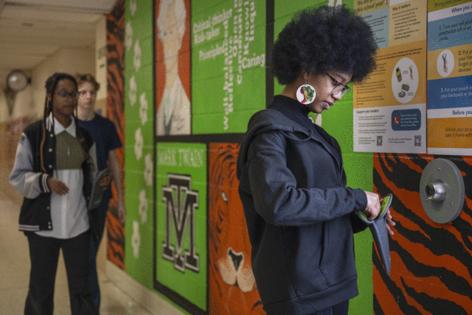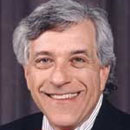Missouri school cellphone ban: Fewer fights, less anxiety, more 'boredom' for students
Published in Lifestyles
ST. LOUIS — It’s lunch time at Kirkwood High School, and students are filtering out of the building.
Two boys make their way to a soccer field and toss a Frisbee. A small group of friends sit in the grass outside the auditorium. A picnic table near the school’s main entrance is full of students working on homework.
Something is noticeably absent from the scene: cellphones.
About a month into the school year, Missouri’s new statewide cellphone ban at public and charter schools largely is being hailed a success.
Educators are reporting more social interaction in classes and at lunch. Students are playing games or reading books instead of scrolling on Instagram or TikTok in their free time. The “lost art” of handwritten notes is back.
Many school districts already limited cellphone use, but the law has brought consistency, said Mark Penny, executive director of Missouri Association of School Administrators, and teachers are reporting stronger engagement.
“Overall, the direction is positive,” Penny said. “We expect the benefits to grow as procedures become routine.”
Student reviews of the policy are more mixed.
The Post-Dispatch spoke with 16 students from seven districts across the area about how the law has impacted them.
Responses ranged from criticism to acceptance — appreciation, even — of a cellphone-free reality that some have never experienced or are too young to remember at school.
Students said fights have declined. Some reported rising moods and declining anxiety. Others said classroom conversations have been more robust.
“I think my brain is more relaxed and refreshed,” Kirkwood High School senior Maggie Dunn said.
Heaven Smith, a sophomore at University City High, said the ban was needed.
“I feel like we’re attached to them,” she said at the end of a recent school day, after she put down her phone to talk to a reporter. “We need to learn how to interact more.”
Others were less positive.
For Angelo Ahuatzi, a Mehlville High School sophomore, school is “more boring.”
“I finish my work, and I can’t do nothing,” Ahuatzi said.
Others said they have not observed much of a difference.
“It’s so much more productive,” Maplewood-Richmond Heights senior Minta Reeves said. “Other than that, you don’t really notice it.”
Eighteen states have banned phones from campuses throughout the school day, with most starting their mandates this school year.
While the benefits of restricting minors’ screen time are well documented, little research has been done on the effects of school phone bans.
Normandy Schools Collaborative in St. Louis County barred students from bringing any personal electronic devices on campus in January and told KMOV in March that out-of-school suspensions had dropped significantly.
Brigette Whaley, an associate professor at West Texas A&M University, studied a high school in Texas last year that required students to put their phones in locked bags.
The teachers she interviewed reported better behavior and student focus in class.
“The absence of having these cellphones or personal devices really helped shift the classroom culture toward a deep connection and more shared learning,” Whaley said.
More enforcement
Missouri’s new law, passed by the Legislature in May, requires public school districts to adopt policies that, at a minimum, prohibit students from displaying or using personal electronic devices from the beginning of the school day to the end.
Most schools already limited the use of cellphones, earbuds, tablets or other devices during the school day. Some had opted for expensive locked pouches to keep phones out of students’ hands, while others opted for classroom cubbies or left it up to students to keep them in their backpacks or lockers.
What has changed with the new law, students say, is enforcement.
Even in districts that previously barred phones during the day, students said school officials are taking phones away far more often and without warning.
Students at Hazelwood East High school said a school employee with a microphone walks around the cafeteria during lunch to call out people on their phones and confiscate the devices.
“There’s no second chance or nothing,” Hazelwood East Middle seventh grader Marli Mays said. “As soon as they see your phone, they just take it. You can’t even have it in your pocket.”
Students in some districts face possible expulsion or time in alternative school if they repeatedly fail to comply with the rule.
Hazelwood School District’s policy says phones will be confiscated on the first offense and returned only to parents at the end of the day.
That presented a problem to at least one parent.
Jessica Campbell said her daughter’s school, Hazelwood East High, closes before Campbell gets off work. Her daughter was walking home after her phone was confiscated one afternoon when a man pulled up next to her in a Chevy with no plates, telling her 10th grade daughter to “get in, they knew her mother,” according to Campbell.
“My child had no way to call me — or the police,” Campbell said.
Some students have found ways to get around the ban.
They hide their devices behind backpacks placed on their desks. Older students go out to their vehicles during lunchtime to check their phones.
Kitie Williams, a junior at Hazelwood East, said she is “very smart about it” and “never gets caught.”
She declined to share her technique but claimed she is not using her phone to text or check social media.
“It was never a distraction for me,” Williams said. “It was actually a help. The teachers don’t teach, or they don’t teach in a direct way.”
“Once my teacher don’t help me, I run straight to ChatGPT.”
Learning independence
Several students said they miss the practical uses of their phones.
Before the new law, some said they could sign up for clubs by using their phones to scan QR codes on flyers. Athletes said it has gotten more difficult to communicate with their coaches and parents about practices and game times.
Some students said the ban prevents them from taking pictures of notes and recording videos of science labs, which they used to reference later.
One of the most common complaints from students was that they no longer are able to access websites that school internet filters block on district devices.
“There’s a lot of research websites you can’t access on a Chromebook,” Maplewood-Richmond Heights senior Terence Askew said.
Jordyn Henderson, a senior at McKinley High in St. Louis Public Schools, said the public address system at her school did not work during the first week of school, which she argued was “an issue of safety.”
“If there was an intruder or anything like that, there was no way to get in contact with the whole building quickly,” Henderson said.
Henderson also said her school did not have access to “reliable” technology. The laptops at McKinley, she said, quickly lose their charge or frequently do not work.
“Last year, if the Wi-fi wasn’t working or the computers weren’t charged, we could take our phone out,” Henderson said.
To Sophia Johnson, a sophomore at Francis Howell North High School, the ban is “overkill.”
Smartphones had become an essential part of education, she said. She also called it a misconception that teenagers want to stare at their phones all day.
“Students in our age group are trying to learn independence,” Johnson said. “I think part of being independent is being able to control yourself on your own cellular device.”
©2025 STLtoday.com. Distributed by Tribune Content Agency, LLC.
























Comments